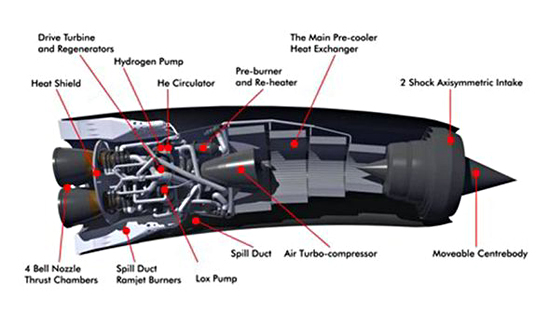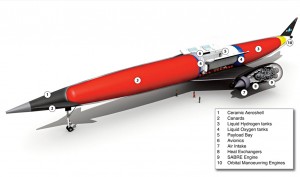
Hypersonic single-stage-to-orbit “space plane” wins backing from U.K.
Mike McLeod
General Aerospace Aerospace European Space Agency rocketReaction Engines’ SABRE rocket and SKYLON plane receives 60 million pounds in government investment.
 Reaction Engines (REL) announced that it’s SABRE engine and SKYLON rocket plane have received £60 million (CAD $95M) in funding from the U.K. government following successful testing of the company’s cutting edge technology by the European Space Agency (ESA). According to the company, the planned SKYLON plane the SABRE engine will power will be able to reach orbit in a single stage, slashing the cost of space travel. The engine, capable of Mach 5 in Earth’s atmosphere, could also be adapted for terrestrial travel, allowing passengers to reach any point on Earth in no more than four hours.
Reaction Engines (REL) announced that it’s SABRE engine and SKYLON rocket plane have received £60 million (CAD $95M) in funding from the U.K. government following successful testing of the company’s cutting edge technology by the European Space Agency (ESA). According to the company, the planned SKYLON plane the SABRE engine will power will be able to reach orbit in a single stage, slashing the cost of space travel. The engine, capable of Mach 5 in Earth’s atmosphere, could also be adapted for terrestrial travel, allowing passengers to reach any point on Earth in no more than four hours.
According to the company, it’s Synergestic Air-Breathing Rocket Engine (SABRE for short) is essentially a rocket engine that works in two modes. In Earth-bound “air breathing” mode, the engine combines its hydrogen fuel with oxygen from the air, similar to a conventional jet engine. To achieve terrestrial speeds up Mach 5 using rocket fuel, however, the SABRE engine incorporates a lightweight Pre-cooler heat exchanger using liquid helium that rapidly chills incoming air to minus 150 degrees Celcius in less than 1/100th of a second. This is used to compensate for heat generated from compressing the air to 150 bar before it can be injected into the combustion chamber. How the engine will deal with the resulting condensation and frost within the engine is a company secret but was validated in testing conducted by the ESA last year.

At altitudes above 25 km, the air intake vents close and the engine switches to conventional rocket mode. A relatively small amount of on-board liquid oxygen would then be used to propel the proposed SKYLON rocket plane to speeds upwards of Mach 22 to make the push into low Earth orbit (around 100km). In both modes, thrust is generated using the rocket combustion chamber and nozzles, made possible by a synthesis of rocket and gas turbine technology.
Freed from multiple stages and the need to carry large amounts of oxydizer (typically 250 tons for a multi-stage rocket), the SKYLON would be a single-stag-to-orbit vehicle intended to be reusable and a significantly less expensive form of space travel. According to Reaction Engines’ plans, SKYLON will be capable of carrying 15,000 kg of cargo to space at 2 percent of conventional launch vehicles.

Presently, Reaction Engines is in the process of developing and further testing is engine technology. Company founder and engineer, Alan Bond, says the £60 million grant will allow REL to perform further design work on the SABRE engine; refine the heat exchanger technology; performing wind tunnel and flight testing; and conduct a ground demonstration of the engine. While 90 percent privately funded, the company says it needs to raise approximately $400 million to continue SABRE development.
If it can secure that funding and development stays on schedule, Reaction Engines foresees a SABRE prototype being ready by 2017, and flight testing to begin in 2020.
www.reactionengines.co.uk
